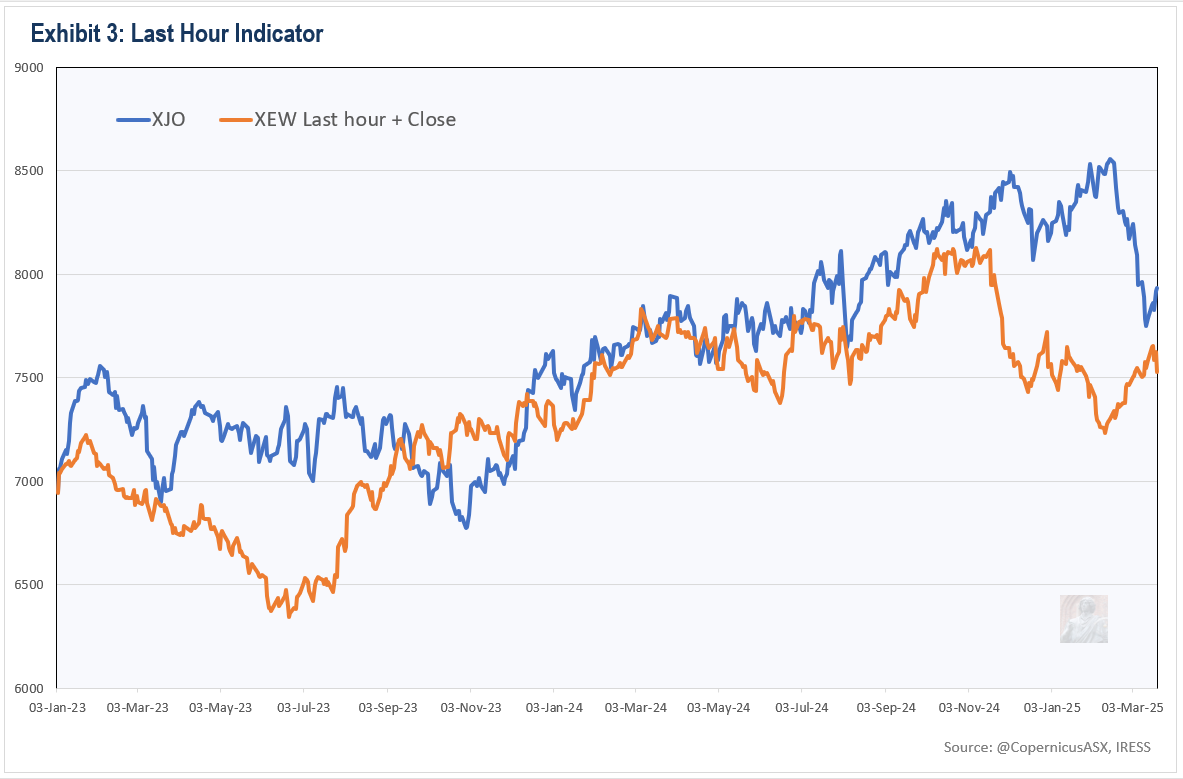Disclaimer: This market letter represents the views and opinions of the author. It does not constitute investment advice. It is my online journal to share knowledge of an alternative philosophy of financial markets and how I use this philosophy to trade. You should consult a financial adviser if you require professional assistance with your portfolio. I am not a financial adviser.
Summary
A meaningful bounce or rally has commenced.
Regarding the outlook for the next 2–3 years, a bear market is highly likely. It will probably commence in 3Q or 4Q2025. From peak to trough, the decline will likely be around 24%. There is the possibility it has already commenced.
A new secular bull market will commence sometime in 2027 or 2028, defined here as a significant multi-decade advance. Wave Structure suggests it will be the greatest bull market in the history of Australian equities.
In the wake
Australia's benchmark share market index, the S&P/ASX 200 (ASX 200), closed at 7931.2 points, gaining 141.5 points or 1.8% for the week.
Exhibit 1 illustrates the price movement for the ASX 200 during the past week.
Last week I wrote that the decline, labelled [C], was likely to be completed this week, probably at a higher low:
Regardless of the scenario, we should see a respite in selling shortly… Looking ahead several weeks to months, the first two interpretations point to a meaningful six-to-seven-week rally commencing from around Wednesday next week (probably from a higher low) with perhaps 8300 to 8400 in the crosshairs.
This week’s rally is consistent with the prevailing interpretation, reinforcing the likelihood that it is correct.
Forecast
Exhibit 2 depicts some interpretations of price behaviour on the daily high-low chart for the ASX 200.1
The first scenario (the prevailing interpretation) is that the ASX 200 is in the early stages of [D] of a NEoWave Neutral Triangle (A-B-C-D-E). This price pattern is depicted with the green labelling. Last week, I rated the probability of this scenario at 75%. The odds of this scenario have marginally increased since last week.
The second scenario is that the ASX 200 is in the early stages of [D] of a NEoWave Expanding Triangle (A-B-C-D-E). This price pattern is depicted with the orange labelling. The odds of this scenario have marginally increased since last week.
The third scenario is that the ASX 200 is in the middle stages of [A], of either a NEoWave Contracting Triangle (A-B-C-D-E) or a NEoWave Flat (A-B-C). Part of this price pattern is depicted with the red labelling. This is the imminent crash scenario. The odds of this scenario have marginally decreased since last week.
In the first two scenarios, the ideal conclusion date for the bottom or end of [C] was yesterday (last week, I wrote Wednesday in error). This date was calculated by taking the average duration of [A] and [B], which is the most common outcome when the prior two waves are different in duration. For Triangles, it is usually not pinpoint accurate (as it is in Flats and Zig Zag price patterns), but nevertheless, you can generally expect the completion of a wave to occur on or very close to the ideal conclusion date.
Reviewing the evidence, it appears that [C] completed on March 14 (long-time readers know I go hunting for bottoms around full moons) at 7755.6 points, marginally higher than the actual low of [C], which occurred two days earlier at 7733.5 points (I ignore price action during the first ten minutes of trading and the after-market auction around 16:10).
There is the possibility that [C] requires a few more trading days to complete, but in this instance, it would likely do so at a level higher than 7808.8 points, because, per NEoWave TIME rules, once the ideal conclusion date has passed, downside potential is over.
Looking ahead, I believe the ASX 200 has 8250 to 8400 in its crosshairs, with [D] peaking or completing in the last week of April or the first week of May.
The expected timeframe for the peak or completion of [D] is calculated by taking the average duration of [B] and [C], which appears to be the best calculation in the current context. It also gels well with seasonality, as markets usually experience a hiccup in May (Sell in May, go away…).
Smart money
Exhibit 3 compares the ASX 200 with the Last Hour Index using the Equal-Weight ASX 200 for its calculations.2
The premise behind this indicator is that professionals with deep pockets are most active during the final hour of trading when liquidity reaches its zenith. This interval also marks the final chance to initiate or liquidate positions within regular trading hours. Therefore, the Last Hour Index offers an alternative view of risk appetite, with turning points in this indicator typically preceding turning points in the benchmark index.
The Last Hour Indicator moved lower this week.
This suggests that a reasonable retracement of the rally will occur in maybe 1-3 weeks from now for the ASX 200, commencing from higher levels.
Market Internals
Exhibit 4 compares the ASX 200 with the Composite Advance-Decline Line (A-D Line).
The A-D Line is a representation of the cumulative total of the number of advancing issues (stocks that closed higher) minus the number of declining issues (stocks that closed lower) each day. When most stocks are moving higher, the A-D Line rises. Conversely, a declining A-D Line indicates that most stocks are moving lower. It provides a strong indication of the health of a market trend. The greater the participation of stocks, the greater the chance the trend will continue in the foreseeable future.
The chart above does not include data for today.
The ASX 200’s all-time high in February was confirmed by a higher high in the AD Line (see green lines). It would therefore be very unusual, but not impossible, for a bear market to have started, if history is any guide.
The AD Line is also outpacing the ASX 200 to the upside during this bounce/rally, which strongly suggests that the crash scenario is not unfolding.
Seasonality
Two weeks ago, I discussed how the month of March often provides investors with a buying opportunity. Typically, the market tends to reach its lowest point around the middle of the month, followed by a rally for the remainder of March and continuing into April.
Exhibit 5 exhibits the monthly returns for the Australian benchmark index since 1980. No matter how you slice and dice the data, April is by far the best month for Aussie equities.
Geomagnetic activity is inversely correlated with market returns and is influenced by at least three short- to medium-term cycles.345 These cycles include the 182.625-day Geomagnetic Cycle, the 173.31-day Eclipse Cycle, and the 29.53-day Lunar Cycle.
The semi-annual Geomagnetic Cycle is the most important of these cycles. It refers to the changes in geomagnetic activity that occur throughout the year, with the highest activity around the equinoxes and the lowest around the solstices. The research scientist Stephen J. Puetz suggests that this cycle is the primary influence on the seasonal pattern observed in financial markets.
Last Friday was a lunar eclipse full moon, and yesterday was the March equinox. The semi-annual Geomagnetic Cycle has now turned up, providing a significant tailwind for stocks.
Risk Management
Over the next one to two weeks, I suspect potential upside risk is capped at 8300 points and downside risk limited to 7808.8 points.
Investment accounts
Yesterday, I purchased 4000 GEAR (BetaShares Geared Australian Equity ETF) at $28.86
This position is akin to having my cake and eating it, too. I wanted to increase my exposure to the long side without spending too much cash as a hedge against a better buying opportunity next week.
Trading Accounts
I have no trading positions at present.
I was hoping for a few more “green flags” to get aggressively long the ASX 200, but in hindsight, additional green flags were unlikely to manifest as this is not the psychological extreme of the pattern, which I believe will occur at a higher low a few months from now.
“Foxy Lady,” the nickname for the fox of the Komna Plateau, who makes the occasional cameo appearance at my favourite mountain hut, Koča pod Bogatinom, in the Julian Alps of Slovenia.
Lexicon
Corrective price pattern: A reaction against the prevailing trend of one larger degree. Overlapping is a common feature although it is not a strict prerequisite. Corrections are an outgrowth of indecision or ambiguity with respect to the future. They are labelled alphabetically (A-B-C etc).
Elliott Wave Principle: the idea that market behaviour is self-affine in nature due to recurrent oscillations in public opinion across different but simultaneous timeframes. It posits that price action can be defined, quantified and classified, and used to project the future evolution of price.
Impulsive price pattern: A fast-moving market. Impulse waves produce a significant change in the price level. A distinctive feature is minimal or no overlapping, depicting a strong level of conviction about the outlook. They contain five segments labelled numerically (waves 1-2-3-4-5).
NEoWave: Neely Extensions of Elliott Wave. The body of knowledge enunciated by Glenn Neely, represents a significant break or extension of the original theory postulated by Ralph Elliott.
Price behaviour: the quantitative assessment of price action. Essentially, the largest, fastest moves are always in the direction of the prevailing psychological trend.
Wave structure: the quantitative relationship between different waves of price action.
Transmission time:
Sydney: 21-March-2025 17:53
Ljubljana: 21-March-2025 07:53
London: 21-March-2025 06:53
New York: 21-March-2025 02:53
A high-low chart plots the period's highs and lows in the order in which they occur. I only utilise price action between 10:10 and 16:00 when the market is fully open.
The ASX 200 Equal Weight Index includes the same constituents as the benchmark ASX 200 Index. The latter is a capitalisation-weighted index, while the former gives each company an equal weighting. The Official Close is included in the calculation.
Stephen Puetz, The unified cycle theory: How cycles dominate the structure of the universe and influence life on Earth (Denver: Outskirts Press, 2009).
Lifang Peng, Ning Li & Jingwen Pan, “Effect of Ap-Index of Geomagnetic Activity on S&P 500 Stock Market Return”, Advances in Astronomy 2019, https://doi.org/10.1155/2019/2748062.
Cesare Robotti & Anya Krivelyova, “Playing the Field: Geomagnetic Storms and the Stock Market”, Federal Reserve Bank of Atlanta Working Paper No. 2003-5b, (October 2003). http://dx.doi.org/10.2139/ssrn.375702









